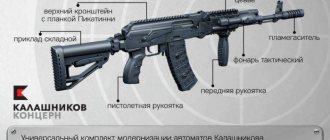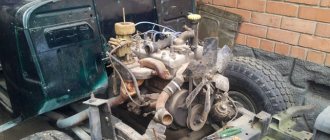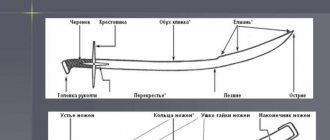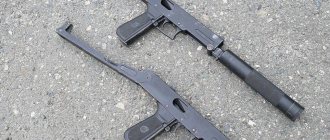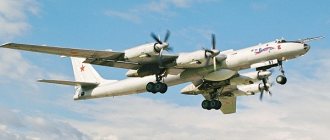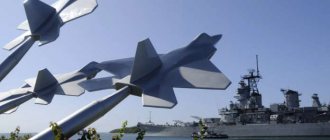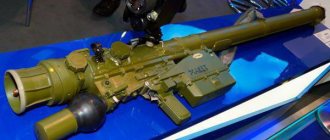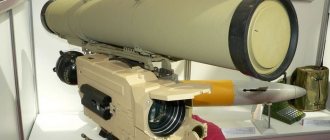American 155 mm self-propelled howitzer M109
The M109 is an American self-propelled artillery unit, a class of self-propelled howitzers that has become the most common in the world. M109 was created in 1953-1960. to replace the unsuccessful M44 self-propelled gun, in parallel with the M108 105 mm caliber. Serially produced in the United States. In the period from 1962 to 2003, it was repeatedly modernized. In the 1990s it was produced under license in South Korea. In total, 9205 self-propelled guns of all modifications were produced. Quite quickly it became the standard self-propelled artillery unit of the US troops, displacing not only older models, but also the M108. The M109's first combat use was during the Vietnam War and was subsequently used in virtually every military conflict involving the United States. In addition to the United States, it has become the standard self-propelled gun of NATO countries.
In the mid-1950s, self-propelled artillery systems took a strong place in US field artillery. However, the participation of the United States in numerous military conflicts around the world and the emergence of nuclear weapons among socialist countries led to the putting forward of new requirements for self-propelled guns. To quickly transport self-propelled guns to any point in the world by air, they had to have a small weight and dimensions. To protect the crew of the self-propelled guns from the damaging factors of nuclear weapons, the armor of the vehicles had to be full. In addition, they were equipped with filter and ventilation units. Not least on the list of requirements was good maneuverability through the use of special vehicles. chassis, overcoming water obstacles by swimming and increasing the horizontal firing sector by using a rotating turret. During this period, the US Army was armed with the 105-mm M52 self-propelled gun and the 155-mm M44 self-propelled gun, created on the basis of the M41 tank. Self-propelled artillery mounts did not meet the new requirements and had some disadvantages, the main ones being: limited firing angle, heavy weight and insignificant range.
To eliminate the disadvantages inherent in the M44 and M52, in 1952 they began to create the T195 self-propelled howitzer of 110 mm caliber. It was decided to use the T195 gun turret and hull as the basis of a self-propelled gun equipped with a 156 mm howitzer. The project for a new howitzer was presented in August 1954, however, it did not receive customer approval. In 1956, for the sake of unification within NATO, it was decided to stick to the 155 mm caliber, and in 1959 the first prototype was completed, which was designated T196. The T196 self-propelled gun was sent to Fort Knox for military testing.
Based on the results of these tests, it was decided that to increase the operating range, all American armored vehicles will be equipped with diesel engines. In addition, a number of changes were made to the design of the hull, turret and chassis. Taking into account the new equipment, the model was given the designation T196E1. In 1961, it was adopted as the M109 SP howitzer. The first production vehicles were produced at the end of 1962 at the Cleveland Army Tank Plant under the direction of Cadillac Motor Car Division, later Chrysler. In total, about 2,500 guns were built at the Chrysler plant. In the 1970s, production of the M109 family was transferred to Bowen McLaughlin-York (today United Defense).
The hull and turret of the M109 self-propelled gun are made of rolled aluminum armor, which provides protection from fragments of field artillery shells, small arms fire and light radiation from a nuclear explosion. The stern and sides of the hull were installed vertically, and the upper frontal plate was installed at a significant angle. The roof of the building is horizontal. At the stern of the self-propelled gun, a closed turret of circular rotation was installed, having an almost semicircular frontal plate. The sides of the tower have rectangular hatches that open backwards.
The M109 self-propelled howitzer adopted a layout with a front-mounted engine-transmission group. At the rear of the hull there was a circular rotation turret with a 155 mm howitzer. The driver's seat is located in the front of the self-propelled gun on the left, the engine compartment is on the right. The tower is located at the rear. The M109 self-propelled howitzer has a rod suspension. There are 7 rollers on each side, a guide drum in the rear and a transport drum in the front. There are no return rollers. The standard equipment includes infrared guiding lights, as well as amphibious equipment, which makes it possible for self-propelled guns to move independently through slow-moving rivers. In the stern there was a double-leaf hatch used for loading ammunition. The crew entered/exited through hatches in the turret rear and side walls, as well as through hatches in the turret roof.
Diesel engine 8V-T71.
The crew of the M109 self-propelled howitzer consists of six people: a driver, a gun commander, a gunner and his assistant, as well as two crew numbers.
The main weapon is a 155mm M126 howitzer with a 23-caliber barrel. The gun is mounted on an M127 machine, equipped with a muzzle brake and an ejector. The vertical guidance angle is -3...+75 degrees, horizontal – 360 degrees. The howitzer is equipped with hydropneumatic recoil devices. The main guidance drive is hydraulic, the auxiliary drive is manual. The gun has a large exhaust device, a muzzle brake and a threaded Welm bolt. The supply of propellant charges and primer tubes is carried out manually. The latter are inserted into the bolt after a projectile with a propellant charge has already been placed in the charging chamber. The maximum rate of fire is 6 rounds per minute. Secondary armament is a 12.7 mm M2HB machine gun mounted above the commander's hatch in the right turret. The machine gun's ammunition capacity is 500 rounds.
The following ammunition is used for the M109 self-propelled howitzer: M712 Copperhead (guided projectile), M107 and M795 (high-explosive fragmentation projectiles), M718/M741, M692, M483A1 and M449A1 (cluster projectiles), M549 (high-explosive fragmentation projectile). ), M485 and M818 (illuminating rounds), M825 (smoke round), M804 (practical round). Carryable ammunition - 28 rounds.
The M109 self-propelled gun is equipped with three M45 periscopes, an M27 periscope, an M118C optical sight with x4 magnification, an M117 panoramic optical sight with x4 magnification and artillery quadrants M1A1 and M15. Night vision devices are also available for driving at night. Some vehicles are equipped with a system of protection against weapons of mass destruction.
The M109 self-propelled howitzer can overcome water obstacles by swimming: the self-propelled gun is held on the water using a special set of flotation devices, which consists of 3 wave-reflecting shields and 6 inflatable rubberized containers. Movement on the water is carried out by rewinding the tracks. The M109 self-propelled gun is capable of firing from the water, but only to produce a “noise effect” since horizontal guidance fails, and turning guidance on the move leads to loss of accuracy.
One of the reasons for the durability of the M109 self-propelled howitzer is that the basic chassis of the vehicle can be upgraded and easily “accepts” long-barreled artillery with a longer firing range.
The M109 family of self-propelled guns includes the following modifications: M109A1 - adopted for service in 1973. The main difference from the base model is the increased barrel length, reinforced suspension and improved guidance drives. It is possible to use M864 cluster shells with a bottom gas generator.
M109A2 - adopted in 1979. The design of the recoil devices and rammer has been changed. Ammunition load increased by 22 rounds.
The M109A3 is an upgraded variant of the M109A1. The gun mount has been replaced. It has an improved driver's instrument panel, a system for removing air from the fuel system, a system for monitoring the condition of the ammunition stowage, recoil brake, knurler and torsion shafts. The maximum firing range of an active-missile projectile has been increased to 24 km, and a high-explosive fragmentation projectile to 18 km. The M109A4 modification is equipped with a system of protection against weapons of mass destruction. Some changes have been made to the power plant, and the horizontal guidance mechanisms have been improved.
M109A5 - equipped with the M284 gun with a barrel length of 39 calibers on the M182 machine. The maximum firing range is 30 km. At the customer's request, it is possible to install an automated fire control system and a GPS system. M109A6 “Paladin” (Paladin) - a modification was developed as part of the HIP program. Entered service in 1992. A new turret has been installed, with improved armor protection and internal lining made of Kevlar. The M284 gun is mounted on the M182A1 machine. Radio station replaced.
The M109A6 self-propelled gun is equipped with a fire control system, a navigation system and an on-board ballistic computer that provide automatic gun guidance. There is a receiver for the NAVSTAR space radio navigation system.
In 1983, a modernized version of the M109A3G was developed in Germany. Production began in 1985. Has a new gun with a barrel from the FH70 “Rheinmetall” howitzer. It is distinguished by more advanced recoil devices, a wedge bolt and a reinforced combat charge introduced into the ammunition load (which made it possible to increase the firing range to 18 km, and the rate of fire to 6 shots). Due to changes in ammunition stowage, the number of rounds increased to 34. The vehicle was also equipped with new West German surveillance devices, sights, tracks, communications equipment, smoke grenade launchers and an MG.3 7.62 mm anti-aircraft machine gun. The M109A3GN modernization was developed in 1988 and was produced for the Norwegian army in 1988-1990. New barrels were installed, which made it possible to increase the firing range.
The M109L is a modernized version of the self-propelled howitzer produced in Italy.
M109A6 PIM is an upgraded version of the M109A6 Paladin. The main goal of the modernization was to extend the service life of the self-propelled guns by 30-40 years.
M109A6 and improving their combat characteristics. The modernized self-propelled howitzer has a digital fire control system and an improved semi-automatic loading system. In addition, hydraulic gun control systems were replaced with electric drives. The basic chassis replaced an improved one with transmission and suspension elements of the M2 Bradley infantry fighting vehicle. The 440-horsepower Detroit Diesel engine was replaced by the M2 Bradley BMP engine (600-horsepower Cummins V903). The US military plans to upgrade the M109A6 out of 975 to the PIM 580 modification.
The US Army received 54 M109 self-propelled howitzers. per one mechanized or tank division (3 divisions of 18 self-propelled guns, per division - 3 batteries of 6 vehicles each). In addition to the Marine Corps and the US Army, M109 self-propelled guns were supplied to Austria (189 vehicles of the M109A2, M109A3, M109A5Ö modifications - as of 2007), Belgium (24 M109 self-propelled guns), Brazil (37 M109A3), Germany (499 M109A3G), Greece (197 M109A1B, M109A2, M109A3GEA1, M109A5), Denmark (76 M109A3DK), Egypt (367 M109A2, M109A2, M109A3), Israel (350 M109A1), Jordan (253 M109A1, M109A2), Iran (180 M109), Spain (112 M1 09A2, M109A5), Italy (260 M109G, M109L), Republic of Korea (1040 M109A2), Kuwait (23 M109), Libya (14 M109), Morocco (44 M109A1, M109A1B), Netherlands (120 M109A3), Norway (126 M109A3GN), UAE (85 M109A3), Pakistan (200 M109A2), Peru (12 M109A2), Portugal (20 M109A2, M109A5), Saudi Arabia (110 M109A1B, M109A2), Thailand (20 M109A2), Republic of China (225 M109A2, M109A5), Switzerland (224 M109U).
The M109 self-propelled howitzer has been used in many conflicts in the Middle East (used by Israel and Iran) and the Far East (used by the United States in Kampuchea and Vietnam).
Tactical and technical characteristics: Combat weight - 23.8 tons; Case length – 6114 mm; Length with gun forward – 6614 mm; Case width – 3150 mm; Height – 3279 mm; Ground clearance – 450 mm; Crew – 4-6 people (depending on modification); Armor type - rolled aluminum Front of the hull (top) - 32 mm/75°; Body forehead (middle) – 32 mm/19°; Body forehead (bottom) – 32 mm/60°; Hull side and stern – 32 mm/0°; Bottom – 32 mm; Housing roof – 32 mm; Turret front and side – 32 mm/22°; Turret rear – 32 mm/0°; Tower roof – 32 mm; Gun type - howitzer; Brand and caliber of gun – M126, 155 mm; Barrel length - 23.4 calibers; Gun ammunition - 28 shots; Vertical guidance angles – from −3 to +75 degrees; Firing range - 19.3 km (with an active-missile projectile); Sights – M42 (periscope), M118C (telescopic), M117 (panoramic periscope); Machine gun – M2HB 12.7 mm caliber; Engine – diesel, V-shaped, 8-cylinder, liquid cooling; Engine power – 405 hp. With.; Highway speed – 56 km/h; Cruising range on the highway – 350 km; Specific power – 15.5 l. s./t; Specific ground pressure – 0.78 kg/cm²; Climbability – 30 degrees; The wall to be overcome is 0.55 m; The ditch to be overcome is 1.85 m; The fordability is 1.05 m, it floats with additional equipment.
Prepared from materials: https://zonawar.ru https://www.thetankmaster.com https://detavlad.ru https://voenteh.com
The history of the creation of the M109 Palladin self-propelled gun
Howitzer b-4
In the early 50s of the last century, enterprises of the American military-industrial complex had serious experience in the production of self-propelled artillery guns. At that time, the main self-propelled guns of the US Army were the 155-mm M44 self-propelled guns and the 105-mm M52 self-propelled guns, created on the basis of the M41 tank.
However, increasing tensions between NATO and the Warsaw Pact, an increase in the number of regional conflicts and the firm belief that a future war would definitely not happen without nuclear weapons forced the US military leadership to authorize the development of a new self-propelled gun.
Old vehicles were not suitable for many reasons: their firing angle was limited, the vehicles had a small power reserve, they had a significant mass, which made them difficult to transport by air.
In 1952, development began on a new vehicle, the T195, equipped with a 110 mm gun. A little later, on the basis of this machine, they decided to create a 156-mm howitzer. In 1956, it was decided to consider the 155 mm caliber as the standard for NATO, and it was for such a weapon that the development of the self-propelled gun continued. In 1959, the first prototype of the T196 was ready and sent for testing.
In 1961, production of a pilot batch of self-propelled guns began, and in 1963 a contract was signed to begin mass production of the vehicles. In the same year, the self-propelled gun began to enter the army and received its current designation - M109.
Initially, the M109 was produced at the Cadillac Motor Car Division plant; since 1970, production was transferred to Bowen McLaughlin-York (United Defense).
The amazing durability of the machine is primarily due to the great modernization potential that was originally built into it. In total, more than ten modifications of this self-propelled gun were manufactured.
Engine and transmission
Soviet howitzer d-30: history, design and performance characteristics
The performance of the Suzuki M109R is simply excellent, allowing the motorcycle to reach high speeds of approximately 225 kilometers per hour. The power is 125 horsepower. The bike can easily accelerate to 100 kilometers in a very short time - only 3.9 seconds.
The engine itself is very powerful and is cooled, allowing the bike to consistently operate at maximum load.
Fuel consumption is not very economical, so the tank volume of 19.5 liters is enough to travel only 300 kilometers.
The motorcycle has a five-speed gearbox with long gears. The transmission is carried out using a cardan, which perfectly exalts all the parameters of this bike.
Notes
- ↑ (English) (pdf). baesystems.com
. BAE Systems (September 2014). Retrieved February 21, 2017. - ↑. Retrieved February 21, 2022.
- ↑
- ↑
- ↑
- ↑
- ↑
- ↑ V. Nesterenko.
West German self-propelled howitzer M109A3G // “Foreign Military Review”, No. 3, 1986. pp. 31-32. - Norway // “Foreign Military Review”, No. 7, 1988. P. 70.
- USA // “Foreign Military Review”, No. 7, 1990. P. 79.
- . armstrade.org
. Global Arms Trade Analysis Center (October 30, 2012). Retrieved January 17, 2022. - V. Nesterenko.
Machine for transporting ammunition // “Foreign Military Review”, No. 12, 1983. P. 87-88. - The Military Balance 2016. - P. 77.
- The Military Balance 2016. - P. 322.
- The Military Balance 2016. - P. 383.
- The Military Balance 2016. - P. 104.
- The Military Balance 2013. - P. 374.
- The Military Balance 2016. - P. 336.
- The Military Balance 2016. - P. 140.
- The Military Balance 2013. - P. 141.
- The Military Balance 2016. - P. 332.
- The Military Balance 2013. - P. 378.
- The Military Balance 2016. - P. 111.
- . Rus.TVNET
(April 27, 2017). Retrieved May 30, 2022. - The Military Balance 2013. - P. 388.
- The Military Balance 2013. - P. 395.
- The Military Balance 2016. - P. 357.
- The Military Balance 2016. - P. 280.
- The Military Balance 2013. - P. 466.
- The Military Balance 2016. - P. 130.
- The Military Balance 2016. - P. 267.
- The Military Balance 2016. - P. 352.
- The Military Balance 2016. - P. 40.41.
- The Military Balance 2016. - P. 338.
- The Military Balance 2016. - P. 293.
- The Military Balance 2016. - P. 387.
- The Military Balance 2016. - P. 146.
- The Military Balance 2007. - P. 103.
- The Military Balance 2007. - P. 116.
- . Retrieved May 31, 2011.
- The Military Balance 2016. - P. 89.
- . TsAMTO
(May 25, 2022). Retrieved May 30, 2022. - The Military Balance 2016. - P. 334.
- (Hebrew). Globes
(14-05-2017). Retrieved May 30, 2022. - The Military Balance 2016. - P. 125.
- (Norwegian). Forsvarsmateriell
(December 20, 2017). Retrieved January 10, 2022. - .
- The Military Balance 2016. - P. 35.
- The Military Balance 2013. - P. 392.
- The Military Balance 2007. - P. 130.
- Armies of the Gulf War, Gordon L. Rottman, Osprey Publishing, 1993. P. 49.
- . voenteh.com. Retrieved November 20, 2022.
- . www.soldiering.ru. Retrieved November 20, 2022.
- . www.soldiering.ru. Retrieved November 20, 2022.
- . military.wikireading.ru. Retrieved November 20, 2022.
- andrei_bt.
. Andrei-bt (November 25, 2014). Retrieved November 20, 2022. - nina811.
. nina811 (July 20, 2014). Retrieved November 20, 2022. - . army.mil
. US Army (20 September 2018). Retrieved December 1, 2018. - PRODUCT 2С19. Technical description and operating instructions for calculating 2S19TO. - Ufa: Goskomizdat, 1990.
- (English) (pdf). baesystems.com
. BAE Systems (September 2014). Retrieved February 21, 2017. - Foss JC
Giat Industries 155 mm GCT self-propelled gun // Jane's Armor and Artillery 2001-2002. - Jane's Information Group, Inc., 2001. - 938 p. — ISBN 9780710623096. - Foss JC
BAE Systems, RO Defense AS90 (Braveheart) 155 mm self-propelled gun // Jane's Armor and Artillery 2001-2002. - Jane's Information Group, Inc., 2001. - 938 p. — ISBN 9780710623096.
Paladin PIM armament
122 mm howitzer model 1910/30
The Paladin M109A7 artillery system is armed with a 155mm M284 cannon with an M182A1 gun mount and an automated loader. The 155mm artillery system can fire at a sustained rate of one round a minute whereas the maximum rate of fire is four rounds a minute. The system has a range of 22km with standard projectiles and 30km with rocket-assisted projectiles.
The Paladin self-propelled howitzer can also be equipped with fire precision munitions, including the Excalibur and the precision guidance kit.
“The self-propelled howitzer can also be equipped with fire precision munitions including the Excalibur and the precision guidance kit.”
The firing range of the upgraded M109A7 Paladin self-propelled gun will reach 70 km
The US Department of Defense and BAE Systems signed a contract worth $45 million. According to its terms, within three years the manufacturer will supply the first batch of components to increase the firing range of cannon artillery (ERCA, Increment 1 Prototype).
A prototype self-propelled gun with a new turret and a gun with a barrel length of 58 calibers is being tested. Photo: thedrive.com
We are talking about a kit for modernizing the fleet of 155-mm self-propelled guns M109A7 Paladin. The first stage of the ERCA kit includes two components - the new XM1113 active-missile projectile and the upgraded XM907 gun with a barrel length of 58 calibers (instead of the existing 39). With it, the firing range of the new projectile with the XM645 propellant charge can reach 70 kilometers. Also, the modernized Paladins will receive a new communication system that can operate in the absence of a GPS signal, and a fully automated ammunition rack.
The first phase of development is carried out in collaboration with specialists from the Combat Capabilities Development Command (CCDC). During the work, the M109A7 self-propelled guns will undergo a major overhaul and will receive a 58-caliber barrel (length - 9.1 meters) and a new breech of the gun. BAE representatives emphasize that the current modernization will double the accuracy and range of fire using the resource of the existing chassis. At the same time, the PGK-AJ (Precision Guidance Kit with Anti-Interference Capability) system, which includes a navigation unit and a guidance station based on an active phased active array, will be tested on the upgraded vehicles.
Demonstration of new self-propelled gun components. Automated ammunition rack, which has led to an increase in the size of the turret, can provide a rate of fire of 8-10 rounds per minute Photo: secretprojects.co.uk
At the moment, BAE Systems specialists are preparing the first batch of M109A7 for conversion. Work on the vehicles will take place at the Picatinny Arsenal research organization.
The M109 howitzer entered service with the US Army in 1963, and its first conflict was the Vietnam War. The 36-ton vehicle is assembled from rolled sheets of aluminum armor, 32 mm thick, which provides protection against small arms fire. In 2012, the self-propelled guns underwent the latest, to date, large-scale modernization. The M109A7 received a gun with a barrel length of 39 calibers, a 675-horsepower engine, a digital control system and a semi-automatic loading system. The US Army has more than 900 such vehicles in service, most of which are in storage.
Shot from an experienced self-propelled gun with a new gun
Found a typo? Select a fragment and press Ctrl+Enter.
Tags: Land equipment BAE Systems Paladin Saudi Arabia USA
Previous article Hide from traffic jams. Elon Musk's company has finished digging tunnels in Las Vegas
Next article F-35 fighter. “We should do everything in the USA”
Provided by SendPulse
Likes 0
Paladin artillery system upgrade
The US Army and BAE Systems signed a memorandum of understanding (MoU) for a partnership to upgrade the Paladin named the Paladin integrated management (PIM) program.
The upgrade retains the space, weight, power cooling, main armament and cab structure but replaces the chassis with Bradley-common chassis. The engine and transmission were replaced with a Cummins 600hp diesel engine and L3 HMPT-500 automatic transmission, also fitted on the Bradley fighting vehicle. The suspension and steering system, as well as survivability, have been improved.
It has a new automated loader, electric gun drive, in line with the future combat systems non-line-of-sight cannon, NLOS-C, and air-conditioning powered by BAE Systems common modular power system (CMPS). The technologies developed under the Crusader and Non-Line-of-Sight Cannon programs, such as a 600V on-board power system, and projectile ramming systems have been improved. The state-of-the-art digital and power-generation capabilities offer the potential for future payloads and accommodation of current network requirements on the battlefield.
The existing 39-caliber turret was replaced by a 58-caliber, 30ft-long gun barrel for doubling the firepower of the vehicle. The M109A7 is fitted with the extended-range cannon artillery (ERCA) to improve the rate of fire and artillery range. The company also developed precision guidance kits with anti-jamming capabilities (PGK-AJ), which are compatible with multiple firing platforms.
Awaiting replacement
Currently, American industry is serially modernizing the existing M109A6 self-propelled howitzers according to the current A7 project. In the near future, this order will be fully completed, which will lead to a noticeable increase in the combat qualities of the artillery. In addition, the result of modernization will be an extension of the resource and service life of the equipment.
Modern modification of the M109A7 self-propelled gun
In parallel, a new self-propelled gun is being developed for the future replacement of existing armored vehicles. However, the XM1299 ERCA project is not the first of its kind. Attempts to replace Paladin have been made since the early 90s, and so far none of them have been successful.
The first attempt in the form of the XM2001 Crusader project failed due to excessive complexity and high cost of the equipment. The second was the XM1203 NLOS Cannon project, which was closed along with the larger FCS program. This time, the reason for the refusal was the inconsistency of the main program with the current views and plans of the Pentagon. Now the industry is working on the XM1299 self-propelled guns and again shows technical success. Whether it will be possible to realize the full potential of this project and bring it to series is a big question.
However, the American military is not prone to pessimism and gives the new development the highest marks. Once again there are statements about high performance and a great future, as well as about the upcoming replacement of old armored vehicles. The near future will show how correct the current estimates are and whether all plans will be implemented.
//
